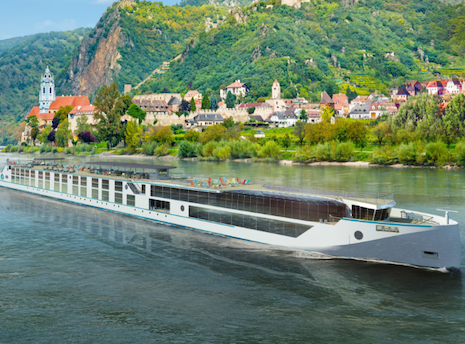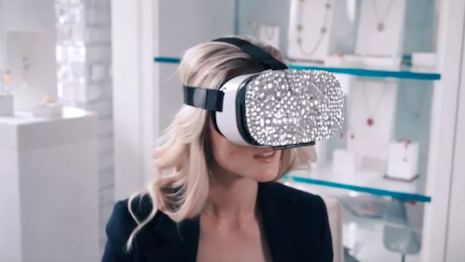NEW YORK – A deep dive into digital data can provide the kinds of insights a brand needs to reinvent its marketing strategy to fit modern consumers.
Speaking at Luxury Interactive 2017 on Oct. 17, a senior executive from Crystal Cruises explained the ways that the company has used data to take a hard look at the mistakes it was making in determining who its customers were. Even for brands that are mainly a physical, in-person experience with little online shopping presence, digital data can still help provide valuable insights.
"One mistake we made was launching without understanding who the customer was," said Oscar Guerrero, senior manager of consumer insights and loyalty at Crystal Cruises.
"When I started, our loyalty program was a bit stale," he said. "Before I jumped in and made changes, I wanted to take a macro view of who our guest is."
Data diving
When Mr. Guerrero joined Crystal, he admits that the company had an incorrect sense of who its customers were and how they were interacting with the brand.
The company was confident in its return rate and the number of people who were continuing to book cruises each year. But additional digging showed that those notions were not as ironclad as they first appeared.
"We did some digging into our database," Mr. Guerrero said. "They were looking at the last two or three years and seeing a 70 percent return rate.
"But if you go back further, 70 precent of first time cruisers never came back. Of the 30 percent that did come back, there was a 35 month lag between first and second cruise.
"Our goal is to reduce that gap as much as possible.

Crystal's new river cruises. Image credit: Crystal
Similarly, the brand was not completely aware of the demographics of its customer base, estimating that the age of the average cruiser was much lower than it actually was.
This presented a problem, as an older consumer base was not as sustainable as a younger, more robust consumer base who are more likely to book repeat cruises.
"Thirty percent of our customers are over 80," Mr. Guerrero said. "I always say our customers are dying and my bosses say 'no, they're just 'aging out.'
"But we are bringing in younger and more adventurous guests."
A new audience
Since discovering the reality of what kinds of customers it attracts, Crystal has been on a mission to create new, digitally-enhanced campaigns that are appealing to young consumers.
For example, Crystal is helping prospective travelers imagine themselves on one of its cruises with the addition of virtual reality technology.
Crystal Preview allows travelers to view Crystal’s Serenity and Mozart ships and select shore destinations in 360 degrees, transporting consumers to the Arctic or locations along the Danube River. Most travelers consult digital channels before booking, making virtual reality another way to help them make decisions about their itineraries (see story).

Crystal has recently brought in VR as a marketing tool for young consumers. Image credit: Crystal
Before Crystal’s captains take the wheel of its river cruise liners, they will train and be assessed on simulators developed through a partnership between its parent company Genting Hong Kong and Netherlands-based Simwave. Leveraging what Crystal claims is the first of its kind technology for the cruise industry, the simulator is expected to increase safety for vessels by letting captains practice on dry land (see story).
Mr. Guerrero also spoke about the methods by which brands need to make each customer’s experience more personalized and unique to them.
"If Megan cruised one time and spent $5000, I cruised 10 times and I spent $100000, why would we get the same email? Without our names on it?" Mr. Guerrero said.
"Customers want to feel like they are known."
{"ct":"+tgSbf6U2r9fJTC\/AKth5IDT4HyYIR1\/lNfP+gAzqFlOdAtrmtiFOWtjNFE1Zx01HE21JLD1Srj0CH3JzbbWmYDEj8jo9t9AAZGFhqSTDoad5rhAC0gz17ImPrTo8U6x4RkWQwuaUFtVPgva0d+uFuFTmxIdjMFIsWA1i7Z0tPc0+T7+H9kqcdzXwcXXs4coJOFH6kCBiAb4mSjLYC\/U400bvPfur2B9E6e+ldJ4xIoY+2cqQsORU+pNxpN0xZXzNd6xhNwzDy\/CVNOS0+PLiZ3OvrSheI66MAF8u72WCf6F0f5EJByoHtFCIXzYdJd\/+GhSnqgzpl0WxsOxR995kGiXLbLLK6Q+jzFcrBBiVZtjd7BZS7zFgC\/c\/hhEJO1S8XF\/t9vnzJFWweFOQbdMDjgb4GhHx5QqAscrjYaE+Q\/XQ+FgNeCcC3lUeOU0bPnoWYG+\/Zr4GnP74uPUUaS0ih03nn87ZQLU2Pi9\/2k9aiASYSn9iu\/3\/FFD4lngmnfJ6Jf3WpiSC5i3JjL2MpUeJNncnaYdRzs+OZVhYayYwCguI3STpuOv241NemRFabDfP\/UW\/Ct0NRoGbMFhtRci7xqJwM+Sj1L60ormYGobSYH0T\/qsxvqkRECZPqZvzWQQ\/EMlbMWLTmN4ccjMYKLuW6MntgKd7RB+N\/CphN6qT3Sm1OyJNrBzUUGSyeE75X4M4QgNlcGNmDUhci1UJpWVPnQoOu\/adVxO9tl9bvlFfgt+dbglA2ThNV0e8VuHLU9fxsvpdKq7gVrrtegYan8YJ4BdTjcegG2nC0XwLe01YzkhK4gKNIyrmbrolwNgPv0LCL0sfRjTCYnHAy1pQkaSbMn7P1Yg8Frx8yIj7140GqR\/QU\/CHqxaL2D0Ke+Rd4V8XBfDzkaf4t\/3pijYfAf0IBB2uRWIa9yFYpeRV4G7hTVOncp8TswKJ23t30U50y7JLJnn0nojnavOrT2TKxlSvXRBKHkdcY9QZo+brlQsOH1\/wCLQ1TdrmEEruSzgfmdvpi4Hz139+I8LH2NZdO+LVJCWzGu9GeVAa0QdWIX+FoljNvLauQs+ABB4iRVRGJAIdiFt891ySEf2UM0yPh8cWQKhafg8E3uK0xBNtG3VHgk\/7aDbKtnBMRUOB0LoUa0mAaiBWg2QYU\/gShZ80kvh9YFo7g+Pphk7vjoJFLPgRP0ZY+jDSNfgsnzhgbuAv9rWCbuATbhOgytAwQXcYyGp7SgHb9tA3Y0d40yQ\/QgkAvjy9q++EYSV1gC8OnWeLerkX5UKd74Wf3yVdJskJ+uXzjD5CjQOWKx3f+fbPe1YdQ7MoDrpo52COqnecferpI58gp0huBqC7iBnB2mQXzpbe7Se26QCUU+kFmpVzjXA8C\/Mi+Zn1CESJuPeWMrNW1IoTKcYXEGm+SdYeIFfn5R30Wo5D8Mrbq4CHzmMk8yDveyCmUHfz\/8819uGC3Pc5\/vajEoMekzZdJYa9AbqrzuQKnaYAx2eF4XpzupBWh5D8d2I90aVcHRawirsQwetz3tpNG3L5eeWnq2y+F9fNJ4BVwl1ugR0gU41Hh8uxF9Nv47cF+tOERDYVMg2R\/lgQrOQlWGkouqkulp\/C9lF3rGECjV9FPsnQGGb\/Wdpmqw3vwY9xdTsJ0j\/BF5QoMwry4QO3au\/XtmQOf+b1NMszIv1zJZJs2C67C9QCO+a9jj7gOX7mK\/l+wH2hJVNMA5PoWUYSYAxemvDrNP6gpdfvQiDHnIAuXNfMD692UE0s\/3ZqkqtcPkzIq9IvVMoxj8p4xttc6bNtnP1rKNs70EZsutor44TFoirEB412yP8gZKkxciHiwK6J5uOOKVfXAW9i\/MT+w2yql4sqs7hkVGYDU3KgaNAShVIVRldifrJPLkZCuwC8TUPjrZ\/1asGJ1vyMMh4PrDn\/jYL378cm+ZRSaxInsVFw6JBwUPbbvDCgcLZGkDeaga9ujVNL8n\/e31dctgvWl+m85NxuZZnVSyCpeiwxXRMpYZHgnN8\/wmjWyT\/rW6eiZitJn8ZZce2frP7IrP0+2onvepb5lg09Sq0u\/\/P++QYiif+4uybdH25toxBrOAreVv0Td2RqnFFVucQp4OrDOJTK3hQN5tMD8D+BK4mIxC90XHo2EvnUR5i00ZmW1x1Nni7\/5oLisQMtBNCrmZ26zpOSsHhz2P3l0\/hYWyznZRuubVhqXvAfEmdUht3TBFm4Akf8QItkoZaUhcQrOSgmkJ7o9JUPw0\/ZQxiwcfFr\/d4nH008LT\/70\/4iOcdr6plZb1hfrc8ZoPYMYlvZHkUzV4UErW+mNs6LFMwsSiRhWgJRKbMNBPTTEKwaIZzxlO2LPOZxWxeRCrvXuw1A+REuEmeUyqwEpAA41q5u762BgG92y\/on0Ct0rZksueuOoWGN80e2sWQhMbejB5Hpuu+cTilNXzd7916abyjjDxvbnd8kzDgSu3TX6oqNKRHI0aRBYPQVwfeGuF9lqmRBhz3o8BGJhISUI859R30upTq21FwA1drr976B+QP78LV0vxoCNmXVD7xjKAyZbMGtSRoTAGkkFazgQeDU50yFwYijw8m4TnQoZ7QjEvj7HLEyLnr0ifTE2x3RXlLPO2ojpvt9KASPXpM1YOPZyaIDeqZvZDJb3ZkdhIv7ZJdTCFArGJCQo3QNOax+nydDPhrp\/r\/n8PkWWvR\/bOjr+B\/GwcMOyfB7nStN9DF8h\/q\/GMISmRjabbTO8Dc5sswYr8Ho8WD\/+d7fEVt8C7gMWCn9XNtEWJu8Xi3LpO\/7131upZiUXOPCD17\/HjE7qfhwivgwfHoSdUZLt3LMo47VAES7EPHdH6qGXf0V5cSTLzNAT2i8gmGGX94jUr3O2860Ila\/P+Z4AO4lUkpLCfvKtGoU3zX9QQ2sNk5JbxurOmJ8FtYg2WQMFquEaIgoTqgm0Wv+zNYuM4rIPmo2M5rKc9ZPEsgiem4blJhTm\/YYA8NP+kCLmjm+aDleJODgM59Y0SqN2l2Xs0R5vNnjjYVu2bybvhC7bAnxM\/RSZJiZ0pO0Azm4PCAUHWWWSO3KpB6xv9\/S5YENOrQCkoP6nx3C+j1cbCFyresi03mLjt0I\/566gTGvMDUpfHLI81MTUnEjk3mE6t88tISTJuF3XdYU7O3ddQFU89PF6G70ReH0LtXUv7j7bZgOsPnQwHH2Kvuhk2kCH9gnpscBujxSCg7bCINVK1HUzYhcF3ZUZjBcJVRWLNlQNxAl8XuaerxmEupq8kSKONn2sDA3VxXE0he8przrln5mvTElwlHsWlRSaBYV2FyTepT+j7GppbeSvSCnFIaAZE9d4mzceF1sXrRdOwamcifYeKgpBOLq2xHSWaZUj6Hl\/4v7Out383UVcVmXN+ISKjTmlVPuZs25DsKI6ThxNybFmy4nK3kQPl+odBXxFa3\/z4BcKQRIB\/GK8QvSosklC4ON1VCmRieeeBAWVyNgELvkQZzPdVZGYuuVthrPvUQwsiERCd2tsKt7VVFwrQt93nKFo3YARj6ZE+PN2TYu3j6IfP7jAOaX5WcdtZdLtLpRqtwxZLqhxo55PL2\/4ntUCpnODasnBo2IRpVAjtdxwApw6vvoG1LMVhXki0iUSWMjL05oO3ttpTM5khOCmRtmCHGIBjadwPKiWBnLwum2leZxy9BvY5D9teTKJeRTEF7Jz7D0FQwNrBWchseJkL1R5eIsPRP+uA3NP6UrZsKlC1t8GbYsqID9TnP7Tu4PHOguLBihsqcY0qmCDmnQLBVoMmRUOTGu7wMJznV7EpMH4VV0V91hdw4rdbx1\/YfdbSb9J\/7fIKgY7D6qaNBvX8VOXY0\/FITmnkFr9ttYQu\/wA5fa75hYtHmmeEKBBSPbT2gl1jdjOHdDUjrtP7mMgzW4EsvXoW\/ehUtGs3NSZnh7JbnmRNtQQ80dUBxz2DdJcL2UnCBZnfx8C8yH+Ev8P5CUKjPxF52QsMCoSYYlIEGt1Iz3sTWHgnw0TkyvcEeU0X86RPbmtyfH1jAgOdvgghwl\/wmaxSRqQWXdjlAYE4WT3IDdYqt\/XRDFO9Viy8BGqyfULGrFjgMJMNKLAxal5LPvHyveigS4s8Dnz\/4IBafPPZIUcokflIqrEW446fiBb9DbTADTopwvJAipa\/QI94jM51jTCy\/aJjmHFW0fm8fKV2MqwvIt\/9TowNXj665vlpOqxD9OdECL4WVZ2nFqOEGuxyKfXi8ivWFv29K2FjQ0ODmWj13fPG4Tj8dbXkNKWSMSiCZEvFLHr5BOvkOp9yz30pKGXG4opfcbmr\/Rl9Oj\/XN5T6YvFzjZoRU0RwMI2V0rx+SFekPsQgNJ7IKx7RXbf\/3gOHoOQx\/RkEWlFv8d+qvu2\/s2HMQEF8BS\/ArDPmmkxhNZ2GVYctbRALsZk56e5udatnlPNOd6jU4sNimhyGUhm30XZEBWDT2q2S0THujTjhw46NmRZC28BSD5f9JAvVsjnzQz+ABDx5Swog8vih71V0z0XHw56LC9yzZwcGz8RaxbI9KQZOG5EyZROXxJNXcq+gIDd0vsdHLJu1\/1O\/Rgh5NdUmK5MelO3+XafQAWH5ue9C2BAyyaxhYIQWHuLEpI8KyEX37n4bXMH\/uWWGJMI8QuLxIZCKYCjt+ungPMmXS03U\/mZwmB0R7HKO2Hqxe4N1CvEA9N06ZLxIlj7OazhaLK6QCuSFwtUniwij7c46HxXE7gUZpPiI8wXslVCSKTOyvDDz+nwzyey9K4643NkY0BhuD9g4Cj2PEw3vPfQT94nvw8U1soFPqH31iArE4VEKKl19lxOQ0RP5X\/N4XOk0OEI52aEp40AGdf\/PCxydR4ZN8HErXk2bSHvrIz5Q5HS7gJTiNwzbOCyez4cGHb\/DVTOC1sqKbCyspLFJ2ko1hX8PzMRpzYd2ZAZ4gVPgx5l+b4FoqhOcbRF+50li7pGjRJP8+HftGHY2euBn9t9I+2eiklAWXX21u3cST5Idcl3j8jBKbYz67Cee5QKjoH43qFw4pltHYm9DK7bFcZNP6FU\/j86W1KfWD1yZq+DnVJ87KOpIBkwJe4koJfitNUsnY\/pCXOhHVrEIJccQnQrv3IwTWiCso7+H9xj3gbCg3FuQdk7feMeDPA6vg0LJwQgkAHqj8\/\/6P8PFy8Fdzf1Od4U7ePKqYvhErFligGauvf8CPELnJ9ZSmZQaMETiE6sri+zFUqdAuPq8kWYeZfd627Fdt36EpJlp9ViwunezRTSodXOlfU\/pKAhi+RgXw8pG9RCoEuhMp4+E2E\/E3WHsTrvrylDNMw0scDd\/yw7F+QQJPdIQ9SIflz62q8dnBIkfKnNpXg88KJ60cV7f5G\/2dlzE9HBhHIJzxgZxI3SFogXrsrrVHfabAgQCzFyiUkHkMjdo40p+ninj0ku8OMNRBpncXGUNgtur9Xcl6PwN2nJAacao0w12mfbmIDOaC9bly4s36CSeeNut48b9e4YFVIlXB1mgyUUhmGtkNWjJB85tWU0M1pQbodXJETqsuFLDFoED44qiyS0z57zILFuz\/hRPG9XgiQKZRGk3lFJcAbIX1hi9seN718QYSyf6noShtgbIMIviWh2Egc0\/JIUsKUJkk2eeski1lrW56RtvwpxLHyG2FWF\/YZTI2xKlixnKZ7cLjzP5QNyf\/kLqi7\/tNuWp4\/e47waZuI2Am2NO+ptsDmxONRfmtfGZmtIB1Q+UvDad3vlVW1JUsMew+d5SlCPVpbTR8ren0nCu1w9Bc9aeuPlnF7S1u0415bK3zktFbrf39gL5Z7rJJwWTKYYCFZsSlc\/HlPZkStK5PEafCUCxCwQu+ze06YyoD2vhCYfOQxE4svCT\/w7+Kjg97M8Eg4AFKgXD7Zj6moEUV3FONU8I2rGIjCaFHs79jBI1+dDUEx72ntgohuPYUNk04ext6UDL5F4amWULtbKCfmPsyt4GVnj4LZF7EmTki1s28W2QYjVc6nIiBfQtKskyJmKHpiS5UDjxmIuoj6e9u042wFOqRF4fkTuB3Cor+AuOHebFkppl7NuOi+MdRx8Q6LyX2CXTVbL4n6B69PW\/3TE6LczRL3wC7WSA4r15q45K2Tn4r6RjbbIRrg4q44a15cWTOMz42aZk5HPBqUE8hXVudBmur0l\/K6+6myJERJeHAtxjkJqgzpgUuDQHcECxC9xmd2GBpp9ZByKs7PrQL0tr7n8xhfDh+AJHN3AQxUXco79JBSyFqXiWgGfeF3YjYJSdEmZAA1p1NY\/A5VmSnUOXb467A4dkmEPpW0b75F5QV5i38+qdP7+joPZe42CvjW1YCbTPerYMPw0Tq1NCvFvhCXW0P965hbWjW2OUK9XqHen9jEtf7SIJbWxVlBv759gSO0IbL1eeaTwzF1W01epQZZ+xWrWaDAusFcSGF+5IfKuw26hohq3wVvO1iiifKP+s7C3heUPNeILSxQkfjreozuK0r1oQCIfLb+WNgL8CZrTD3ligTTqm5eic7pRpIV5AR3kSrHifT800EMx9V4+FeTT2xeXPGJR7fr1iGrb+BwlTdCWQQ8EYGi7uRb+OrZS2zdORvQZT+wwAc3I6yPMnV4epYV\/3X48CEEqV4x0uJY4R1TqGbIjzxo+ZfOBvJEWrfJQ5907n0nHnECN2uXHukuWogshQJhHnC3hSEqOgRzzsdM1kwg\/FZx3WAIIG6+nXe69xpw19hWaz\/AMh1erKQlJd2YPf7gJ1htEgFkDE2Fx6aRrQ6hN2Y3Su3WKifXPo+QzGbnEZ0I6E8kkWJJBSraPT2NbAqN3rrEFQ6xZBvod565a9C\/MzBNN8OFJcWv8dAc4Q8wa52vXfnQ7\/vdZBZpOkLfMzWQZqIEVTKNJkhE0oToHQtqcmpM+NpLEi9UrI=","iv":"1759685b3f94ab701f2ac2a9bbbcaa9c","s":"a50cba074c2503b7"}

 Data diving can sometimes yield surprising insights into customer segmentation. Image credit: Crystal
Data diving can sometimes yield surprising insights into customer segmentation. Image credit: Crystal